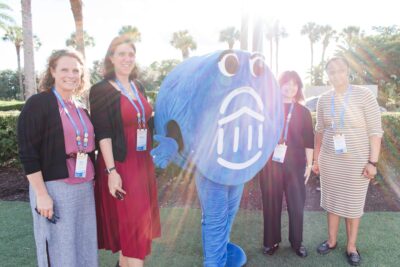3 ways to engage students in the perfect program
Sally declares a forensic science major…despite a deep-seated fear of blood. John dreams of becoming an early childhood educator…but wants a six-figure paycheck. I too, fell victim to program mismatch; I briefly considered a career in international development before finally admitting a distaste for flying and a need for the creature comforts of home.
In reality, most academic advisors can rattle off a list of students enrolled in poor-fit programs who could have benefited from career counseling—but never got there.
Students don’t know that career counseling is an option—or where to find it
Career counseling is notoriously difficult in higher education, particularly at community colleges, where faculty advisors onboarding new students are generally unfamiliar with career resources on campus and so don’t shuttle students in that direction.
Campus design doesn’t help, either; at the majority of community colleges I visited to understand the new student onboarding experience first-hand, one thing that stuck out to me was how physically isolated career services tends to be from all other student services offices on campus.
Without explicit directions or a centrally located office, students rarely seek career exploration on their own. Consequently, they choose academic programs and career goals that are misaligned with their skills, interests, and long-term goals.
College leaders should resolve this “program mismatch” by redesigning career counseling altogether so that it becomes more of an exploratory screening process. Below are three interactive, skills-based career exploration activities that help students screen for the right programs—and help higher education leaders screen for the right students.
1. Spark students’ interest with jargon-free program explanations
By far students’ favorite part of our Navigate360 onboarding platform is the major exploration feature, which uses a short series of questions (e.g., What are your favorite activities? What were your favorite subjects in school?) to identify the best meta-majors and academic programs to suit their interests. In a way, this is the opportunity for college leaders to screen students for the right programs on campus. If a student doesn’t select “science” as their favorite subject or “helping people” as a favorite activity, then it’s unlikely she’ll succeed in a nursing program.
For students, online major exploration is a chance to learn about a particular discipline or career field, and eliminate those that don’t meet their interests.
Descriptions must be written in a way students can understand—using plain-English descriptions of the academic requirements as well as the job skills and daily responsibilities of careers in that field. Radiologic technology on its own might be a mystery (and a mouthful), but knowing that technologists are responsible for operating x-ray equipment and administering radiation therapy makes it a lot easier for students to understand and make an informed decision about enrolling in that program.
The first step for academic administrators is to write program descriptions that are clear, succinct, and jargon free. If your institution is a member of the Navigate collaborative, these descriptions will be loaded directly into the platform for students to review as part of their program selection.
Read our Q&A with the Center of Plain Language on Effective Student Communication
2. Engage students with a hands-on career open house to bring the experience to life
Jobs in the abstract are very different from jobs in reality. Students may want to study a discipline out of academic or personal interest, but find their skills and priorities at odds with the day-to-day demands of the job.
College leaders can avoid this program mismatch by giving students a chance to see common workplace tools and even step into real workplace settings during a career open house. This can be a formal event for multiple career programs, or a showcase for a single program on campus. Students have the chance to “test drive” that career: do they enjoy operating the type of equipment required for the job, mind wearing the safety gear, or enjoy the environment of the workplace? These seemingly small details could be deal-breakers for some students; better for them to learn now before they invest in a particular program.
College leaders can use a career open house as a chance for early skills assessment—are there students with a knack for the skills required to weld metals, take blood, or saw wood? If so, these might be early indicators of their long-term success in the relevant career programs and a chance for early, targeted recruitment.
3. Provide a program sneak peek with “try-before-you-buy” options
The best method of matching the right students to career programs is to let them try the program before enrolling. This, of course, can be more costly for the institution and a much larger commitment for the student than the strategies listed above. However, for programs suffering from high attrition rates and low completion, a try-before-you-buy model can be a great opportunity for both students and the college to determine if the student is the right candidate for the program.
A try-before-you-buy model can take many forms, from one-day workshops to weeks-long intensives, depending on institutional resources and the type of student recruited. Current high school students typically have more time to invest than working adults, for instance.
All previews should engage students in meaningful activities that mimic what the academic program and career training is really like. Instructors can lead participants through a project from beginning to end, with lessons infused throughout that reflect the wide range of skills and tasks required for success in the featured career field.
For instance, Lakeshore Technical College’s Project Mini-Chopper is a try-before-you-buy dual enrollment program for local high school students. During a semester, students build a motorcycle from scratch—while also learning the modern skills required for careers in advanced manufacturing.
Project Mini-Chopper is fun for participants and provides an early opportunity to see which high school students are well-suited to enroll in the college’s advanced manufacturing program. Lakeshore even uses the program to start recruiting top talent. At the end of the semester, students who build the best motorcycle are rewarded with tuition vouchers to apply towards advanced manufacturing courses at the college.
More Blogs

EAB Wrapped 2025: A year of reckoning—and reinvention—in higher ed

Four signs it’s time to break up with your student CRM
